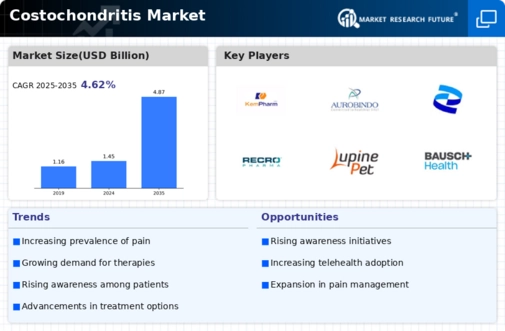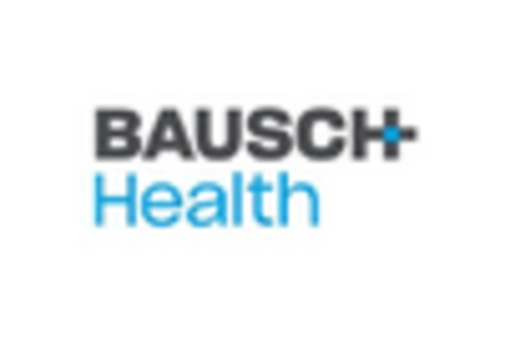-
Definition
-
Research
-
Assumptions
-
Limitations
-
Research Methodology
-
Introduction
-
Primary Research
-
3.3
-
Secondary Research
-
Market Size
-
Estimation
-
Chapter 4. Market Dynamics
-
4.1
-
Drivers
-
Restraints
-
4.3
-
Opportunities
-
Challenges
-
Macroeconomic Indicators
-
Technology
-
Trends & Assessment
-
Chapter 5. Market Factor Analysis
-
Porter’s Five Forces Analysis
- Bargaining
- Threat of New Entrants
- Threat of Substitutes
- Intensity of Rivalry
-
5.1.1
-
Bargaining Power of Suppliers
-
Power of Buyers
-
5.2
-
Value Chain Analysis
-
Investment Feasibility Analysis
-
Pricing Analysis
-
Chapter 6. Global
-
Costochondritis Market, by Diagnosis
-
Introduction
-
Tests
- Echocardiogram
- Cardiac catheterization
- Chest X-ray
- Cardiac MRI
- CT scan
-
6.2.2
-
Electrocardiogram
-
Chapter 7. Global Costochondritis
-
Market, by Treatment
-
Introduction
- Nonsteroidal anti-inflammatory drugs
- Narcotics
- Antidepressants
- Anti-seizure drugs
-
7.2
-
Medications
-
Therapy
- Stretching exercises
-
7.3.2
-
Nerve stimulation
-
Surgery
-
Chapter 8.
-
Global Costochondritis Market, by End-Users
-
Introduction
-
Hospitals and clinics
-
Ambulatory
-
Surgical Centers
-
Diagnostic Centers
-
8.5
-
Research centers
-
Others
-
Chapter 9.
-
Global Costochondritis Market, by Region
-
Introduction
-
America
- North America
- South
-
9.2.1.1
-
US
-
America
-
Europe
- Western Europe
- Eastern
-
9.3.1.3
-
Italy
-
Europe
-
Asia-Pacific
- Japan
- China
- India
- Republic of Korea
-
9.4.4
-
Australia
-
9.4.6
-
Rest of Asia-Pacific
-
Middle East & Africa
- United Arab Emirates
- Saudi
- Oman
- Kuwait
- Qatar
- Rest of the Middle
-
Arabia
-
East & Africa
-
-
Chapter 10. Company Landscape
-
Introduction
-
10.2
-
Market Share Analysis
-
Key Development
- Key Developments
-
& Strategies
-
Chapter 11 Company Profiles
-
KemPharm
- Company
- Type Overview
- Financials
- Key
- SWOT Analysis
-
Overview
-
Developments
-
GlaxoSmithKline plc
- Type Overview
- Financial Overview
- SWOT Analysis
-
11.2.1
-
Company Overview
-
11.2.4
-
Key Developments
-
Biovail Corporation
- Type Overview
- Financial Overview
- SWOT Analysis
-
11.3.1
-
Company Overview
-
11.3.4
-
Key Development
-
Aurobindo Pharma
- Type/Business
- Financial Overview
- Key Development
-
11.4.1
-
Company Overview
-
Segment Overview
-
11.4.5
-
SWOT Analysis
-
Pfizer Inc.
- Company Overview
- Financial overview
- Key Developments
-
11.5.2
-
Type Overview
-
11.5.5
-
SWOT Analysis
-
Recro Pharma
- Company Overview
- Type Overview
- Key Developments
- SWOT Analysis
- Overview
- Type Overview
- Key Developments
- SWOT Analysis
-
Inc.
-
11.6.3
-
Financial Overview
-
11.7
-
LUPIN
-
11.7.3
-
Financials
-
BAUSCH HEALTH COMPANIES INC.
- Type Overview
- Financials
- SWOT Analysis
-
11.8.1
-
Overview
-
11.8.4
-
Key Developments
-
Avenue Therapeutics
- Type Overview
- Financials
- SWOT Analysis
-
11.9.1
-
Overview
-
11.9.4
-
Key Developments
-
Others
-
Chapter 12 Appendix
-
-
LIST OF TABLES
-
Global
-
Costochondritis Market Industry Synopsis, 2020–2027
-
Table 2
-
Global Costochondritis Market Estimates & Forecast,
-
Global
-
Costochondritis Market, by Region, 2020–2027, (USD Million)
-
Table 4
-
Global Costochondritis Market, by Diagnosis, 2020–2027,
-
(USD Million)
-
Global Costochondritis
-
Market, by Treatment, 2020–2027, (USD Million)
-
Table 6
-
Global Costochondritis Market, by End-User, 2020–2027, (USD Million)
-
North America: Global Costochondritis Market, by Diagnosis,
-
North America: Global
-
Costochondritis Market, by Treatment, 2020–2027, (USD Million)
-
Table
-
North America: Global Costochondritis Market, by End-User, 2020–2027,
-
(USD Million)
-
US: Global Costochondritis Market,
-
by Diagnosis, 2020–2027, (USD Million)
-
US:
-
Global Costochondritis Market, by Treatment, 2020–2027, (USD Million)
-
Table
-
US: Global Costochondritis Market, by End-User, 2020–2027,
-
(USD Million)
-
Canada: Global Costochondritis Market,
-
by Diagnosis, 2020–2027, (USD Million)
-
Canada:
-
Global Costochondritis Market, by Treatment, 2020–2027, (USD Million)
-
Table
-
Canada: Global Costochondritis Market, by End-User, 2020–2027,
-
(USD Million)
-
South America: Global Costochondritis
-
Market, by Diagnosis, 2020–2027, (USD Million)
-
South
-
America: Global Costochondritis Market, by Treatment, 2020–2027, (USD Million)
-
South America: Global Costochondritis Market, by End-User,
-
Europe: Global Costochondritis
-
Market, Diagnosis, 2020–2027, (USD Million)
-
Europe:
-
Global Costochondritis Market, by Treatment, 2020–2027, (USD Million)
-
Table
-
Europe: Global Costochondritis Market, by End-User, 2020–2027,
-
(USD Million)
-
Western Europe: Global Costochondritis
-
Market, by Diagnosis, 2020–2027, (USD Million)
-
Western
-
Europe: Global Costochondritis Market, by Treatment, 2020–2027, (USD Million)
-
Western Europe: Global Costochondritis Market, by End-User,
-
Eastern Europe: Global
-
Costochondritis Market, by Diagnosis, 2020–2027, (USD Million)
-
Table
-
Eastern Europe: Global Costochondritis Market, by Treatment,
-
Eastern Europe: Global
-
Costochondritis Market, by End-User, 2020–2027, (USD Million)
-
Table 28
-
Asia-Pacific: Global Costochondritis Market, by Diagnosis, 2020–2027,
-
(USD Million)
-
Asia-Pacific: Global Costochondritis
-
Market, by Treatment, 2020–2027, (USD Million)
-
Asia-Pacific:
-
Global Costochondritis Market, by End-User, 2020–2027, (USD Million)
-
Table
-
Middle East & Africa: Global Costochondritis Market, by
-
Diagnosis, 2020–2027, (USD Million)
-
Middle
-
East & Africa: Global Costochondritis Market, by Treatment, 2020–2027,
-
(USD Million)
-
Middle East & Africa: Global Costochondritis
-
Market, by End-User, 2020–2027, (USD Million)
-
-
LIST OF FIGURES
-
Research Process
-
Segmentation
-
for the Global Costochondritis Market
-
Market
-
Dynamics for the Global Costochondritis Market
-
Global
-
Costochondritis Market Share, by diagnosis 2020
-
Global
-
Costochondritis Market Share, by treatment, 2020
-
Global
-
Costochondritis Market Share, by End-User, 2020
-
Global
-
Costochondritis Market Share, by Region, 2020
-
North
-
America Costochondritis Market Share, by Country, 2020
-
Figure 9
-
Europe Prescribed Health Apps Share, by Country, 2020
-
Figure 10
-
Asia-Pacific Costochondritis Market Share, by Country, 2020
-
Figure 11
-
Middle East & Africa Costochondritis Market Share, by Country, 2020
-
Global Costochondritis Market: Company Share Analysis,
-
KemPharm: Key Financials
-
Figure 14
-
KemPharm: Segmental Revenue
-
KemPharm: Geographical
-
Revenue
-
GlaxoSmithKline plc: Key Financials
-
GlaxoSmithKline plc: Segmental Revenue
-
Figure
-
GlaxoSmithKline plc: Geographical Revenue
-
Figure 19
-
Biovail Corporation: Key Financials
-
Biovail
-
Corporation: Segmental Revenue
-
Biovail Corporation:
-
Geographical Revenue
-
Aurobindo Pharma: Key Financials
-
Aurobindo Pharma: Segmental Revenue
-
Figure 24
-
Aurobindo Pharma: Geographical Revenue
-
Pfizer
-
Inc.: Key Financials
-
Pfizer Inc.: Segmental Revenue
-
Pfizer Inc.: Geographical Revenue
-
Figure 28
-
Recro Pharma Inc.: Key Financials
-
Recro Pharma
-
Inc.: Segmental Revenue
-
Recro Pharma Inc.: Geographical
-
Revenue
-
LUPIN: Key Financials
-
Figure 32
-
LUPIN: Segmental Revenue
-
LUPIN: Geographical
-
Revenue
-
Bausch Health Companies Inc.: Key Financials
-
Bausch Health Companies Inc.: Segmental Revenue
-
Bausch Health Companies Inc.: Geographical Revenue
-
Avenue Therapeutics: Key Financials
-
Figure 38
-
Avenue Therapeutics: Segmental Revenue
-
Avenue
-
Therapeutics: Geographical Revenue











Leave a Comment